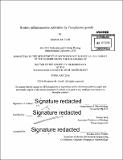Rodent inflammasome activation by Toxoplasma gondii
Author(s)
Cirelli, Kimberly M
DownloadFull printable version (20.97Mb)
Other Contributors
Massachusetts Institute of Technology. Department of Biology.
Advisor
Jeroen Saeij.
Terms of use
Metadata
Show full item recordAbstract
Toxoplasma gondii is an obligate intracellular pathogen capable of chronically infecting nearly all warm-blooded animals, including humans. The chronic stage is characterized by the presence of semi-dormant cysts in brain and muscle tissues. These cysts are crucial in the success of Toxoplasma as they are orally infectious and allow for the transmission of the parasite between hosts. As the host immune response drives cyst formation, the establishment of this chronic infection relies on the parasite's ability to find a balance between activation of a host immune response and evasion of parasiticidal mechanisms. This balance is achieved through the modulation of host cell processes by parasite proteins secreted from specialized secretory organelles known as rhoptries and dense granules. Here, we report that Toxoplasma activates the inflammasomes in mice and rats. The inflammasomes are a set of cytoplasmic pattern recognition receptors (PRRs). Activation of the inflammasomes results in caspase-1 activation and the cleavage and release of the pro-inflammatory cytokines, Interleukin (IL)-1[beta] and IL-18. IL-1p is an important mediator of local inflammation and neutrophil recruitment. IL- 18 induces Interferon (IFN)-[gamma], which is a critical cytokine in the control of Toxoplasma. A form of cell death, termed pyroptosis, can accompany inflammasome activation. The NLRP3 inflammasome is activated in mouse macrophages, leading to the secretion of IL-1[beta] in vitro. The NLRP1 and NLRP3 inflammasomes play a major role in mouse survival and control of parasite replication in vivo. The NLRPI inflammasome is activated in infected macrophages from rats that are able to completely clear infection. Toxoplasma infection leads to the secretion of active IL-I[beta] and IL-18. Activation of the NLRP1 inflammasome leads to pyroptosis, a programmed form of cell death. Pyroptosis prevents parasite replication within the host cell and likely promotes clearance by nearby immune cells. Using a chemical mutagenesis screen, we identified three Toxoplasma dense granule proteins (GRAs), GRA18, GRA27 and GRA28, essential for NLRP1 inflammasome activation and pyroptosis in rat macrophages. Our work has identified Toxoplasma gondii as a novel activator of the rodent inflammasomes and demonstrated host cell death as a mechanism to control parasite replication. We have also identified three novel parasite proteins required for this activation, providing insight into interactions between parasite and host, which may aid in the treatment of human infection.
Description
Thesis: Ph. D., Massachusetts Institute of Technology, Department of Biology, 2016. Cataloged from PDF version of thesis. Includes bibliographical references.
Date issued
2016Department
Massachusetts Institute of Technology. Department of BiologyPublisher
Massachusetts Institute of Technology
Keywords
Biology.